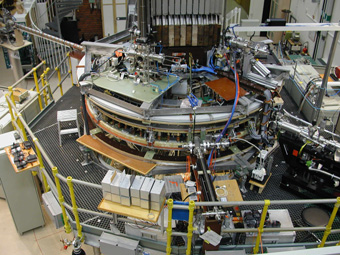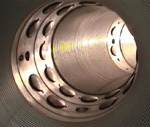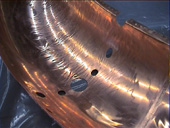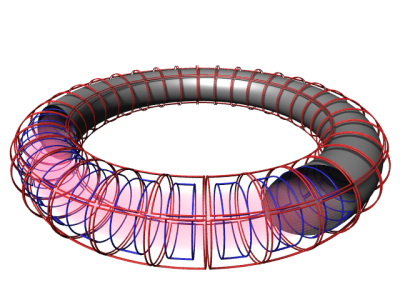Plasma Control
We proudly house a magnetic confinement fusion device named EXTRAP T2R equipped with a digital feedback control system. The experimental research on EXTRAP T2R is led by Professor Per Brunsell.

The EXTRAP T2R Device
The EXTRAP T2R device is a medium-sized reversed-field pinch (RFP) located at the Alfvén Laboratory in the Royal Institute of Technology, Stockholm (Sweden). The experiment received EURATOM priority status in 1990 and the first plasma operation occurred in 1994. The front-end of the device was rebuilt in 2000 and equipped with a new resistive shell. This modification has made it possible to study the stability of resistive wall modes (RWM) and to carry out tests of active feedback control of these RWMs. These studies are the main focus of the programme.
The RFP configuration is an axisymmetric toroidal configuration related to the tokamak, but with a different spatial dependence of the toroidal and poloidal magnetic fields. The resistive wall mode active control studies that are being carried out contribute to the tokamak programme. These RFP studies are carried out in collaboration with the theory group at the Division of Electromagnetics, Chalmers Technical University, Gothenburg (Sweden). The Chalmers group is active in developing the theory and modelling of RWM stability and RWM active feedback systems for the tokamak configuration. Generic features of the physics basis for active mode control are being tested on the EXTRAP T2R device. The RFP experiments carried out on T2R are more flexible than can be done on a large tokamak and therefore these experimens are a good test bed for RWM active control modelling.
Objectives and Achievements

The studies of resistive wall mode (RWM) control is the main focus of the programme. (Collaboration with Consorzio RFX, Padua (Italy) and Dept. Electromagnetics, Chalmers University of Technology, Gothenburg (Sweden). The T2R studies are a part of the European effort in the RWM area. The field penetration time for the shell is long compared to the tearing mode relaxation cycle time scale, but short compared to the pulse length. Under these conditions, the tearing modes, which are ubiquitous in an RFP, exhibit spontaneous rotation. This has never been seen in previous resistive shell RFP experiments. This expedites the study of RWM stability since the stationary RWMs can be easily distinquished from the rotating tearing modes. The observed RWM mode growth is on the time scale of the shell penetration time so the modes can be detected an feedback controlled in the regime where linear theory is applicable.

In addition to the RWM studies, the dynamics of the rotating tearing modes is another area of research. A force balance determines the rotation dynamics which can include non-lineary phenomena such as three-wave coupling and mode phase alignment. The goal is to contribute to the development of a comprehensive model for the tearing modes including both the time dependence of the mode spectrum and the rotation dynamics. Another area is statistical studies of turbulence in the edge region (collaboration with Consorzio RFX). Turbulence studies are of fundamental interest for magnetic confinement and are relevant for comparison studies with the tokamak and stellarator configurations. The turbulence is intermittent. The coherent structures, and associated transport, are affected by shear in plasma flow. Confinement issues in the RFP configuration are investigated. Current profile modification experiments through Pulsed Poloidal Current Drive (PPCD) experiments are performed. (Collaboration with MST, Univ. Wisconsin-Madison (USA) and TPE-RX, Tsukuba (Japan), through the IEA RFP Implementing Agreement). EXTRAP T2R is one of few devices in the EU with an all metal first wall (stainless steel vacuum vessel with Molybdenum limiter array). Studies include plasma surface interaction and hydrogen recycling in an all-metal first wall device.
The plasma physics studies in the EXTRAP T2R programme are pursued through theory, computation and experiment. In addition to the studies for magnetic fusion, there are many universal phenomena generic to complex dynamical systems that are evident in T2R plasmas such as magnetic reconnection, turbulence, chaos and self-organisation.
EXTRAP T2R Parameters
| Parameter | Value | Unit |
|---|---|---|
| Major radius | 1.24 | m |
| Minor radius | 0.18 | m |
| Plasma current | 100-300 | kA |
| Shell time constant | 6 | ms |
| Plasma pulse length | 15-100 | ms |
| Toroidal loop voltage | 20-30 | V |
| Iron core flux swing | 5 | Vs |
| Electron temperature | 200-300 | eV |
| Plasma density | 0.5-2 | 1e19 m^-3 |
RWM Control System
The features of the resistive wall mode control system installed on EXTRAP T2R includes a close-fitting passive stabilising shell with a shell time constant of 6 ms. Pulse lengths are 20-25 ms allowing RWMs to be observed for 3-4 shell times.

A sensor array of 256 radial field flux loops at 4 poloidal and 64 toroidal positions is installed inside the shell. The flux loops with 90 degrees poloidal extent and 360/64=5.625 degrees toroidal width completely cover the shell surface. For the present feedback operation, a subset of 4x32=128 equally spaced coils are used. The coils are pair-connected for "m=1" mode suppression forming 64 sensor signals. The active array consists of 64 saddle coils at 4 poloidal and 16 toroidal positions. It is located outside the shell. The active coil are "m=1" pair connected into 32 active coils. Each coil has an L/R time of 0.7 ms. Professional audio amplifiers with 600 Watt output power per channel are used for driving the active saddle coils. The saddle coils produce a radial field at plasma boundary of the order of 1 mT. A set of 32 independent analog PID controllers are used for the intelligent shell operation.
A digital control system that is a prototype of the system to be used on the RFX device (Padua, Italy), is used for mode control operation. The mode control method of operation allows selective feedback action on individual unstable modes. The controller includes ADCs that input and digitize 64 sensor signals, a CPU that performs a real-time spatial FFT of the 64 sensor signals, applies a feedback law to individual modes, and computes the inverse spatial FFT, and finally DACs that output 32 control signals to the power amplifiers. The digital controller is operated at a clock frequency of 10 kHz. The digital controller allow different closed-loop and open-loop control schemes to be tested. It includes RWM intelligent shell and mode control feedback methods as well as controlled experiments on tearing mode rotation braking and error field penetration thresholds.
Milestones
| Year | Milestone |
|---|---|
| 1990 | The EXTRAP T2 project received EURATOM priority support. |
| 1991 | Originally built and operated at General Atomic, San Diego (USA) with the name OHTE, the reconstruction of the device now name EXTRAP T2 started at the Alfvén Laboratory in a specially-build experiment hall. |
| 1994 | First plasma operation of the device as EXTRAP T2 with the original thin shell and graphite first wall. |
| 1999 | Rebuild started of the front-end of the device; vacuum vessel, copper shell, and toroidal field coil. The new features of the machine included a longer shell time constant, an all metal first wall (molybdenum limiters), reduction of field errors. |
| 2000 | First plasma operation in the rebuilt EXTRAP T2R device with a medium time constant shell and an all metal first wall. |
| 2000 | For the first time in a thin shell RFP suppression of tearing modes by spontaneous rotation and global plasma parameters similar to conducting shell devices. The enhanced performance is attributed to the successful change of front-end system. |
| 2003 | The first comprehensive study of resistive wall modes (RWM) in an RFP. Results showed quantitative agreement between experimental growth rates and linear MHD theory predictions. |
| 2003 | A new extensive RWM feedback stabilization system was installed including a set of 4x16=64 active saddle coils distributed over the shell surface forming a so called intelligent shell. |
| 2004 | The first experiments in an RFP with feedback suppression of RWMs using an intelligent shell were performed. The results showed significant improvement in global plasma performance (50% increase of the pulse length). |
| 2005 | Installation of a complete array of 4x32=128 saddle coils, covering the full surface of the torus. The array is designed to provide multiple-mode stabilization for a wide range of RWMs that are unstable in the RFP configuration. |
| 2005 | First demonstration in an RFP experiment of RWM feedback stabilization of the full unstable spectrum of about 15 independent eigenmodes. The RWM suppression allowed a doubling of the plasma pulse length. |
| 2007 | Intelligent shell feedback with PID control was implemented for better steady state error suppression. The improved feedback control method yielded a five-fold extension of the pulse length to 96 ms, corresponding to 16 wall diffusion times. |
| 2010 | Output tracking feedback control was implemented in order to generate well defined external magnetic perturbations (MP). This feature enables detailed physics studies on EXTRAP T2R of MP-plasma interaction such as field penetration, plasma flow braking and tearing mode dynamics. |
| 2012 | System identification methods were implemented and utilized to estimate RWM spectral characteristics from closed-loop operational input-output data. Theoretical growth rate spectra for the RFP were well reproduced. |
| 2016 | Model based control algorithms for RWM feedback stabilization based on system identification were developed and the first demonstration of Model Predictive Control (MPC) was successfully performed. |
